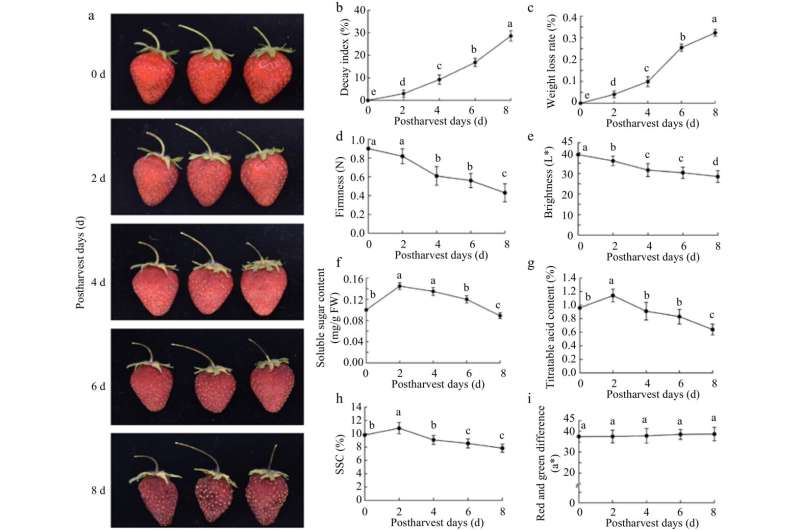This article has been reviewed according to Science X's editorial process and policies. Editors have highlighted the following attributes while ensuring the content's credibility:
fact-checked
proofread
Insights into strawberry senescence: Hormonal interplay key to extending shelf life of 'Benihoppe' variety

A research team discovered that the rapid senescence of harvested strawberry "Benihoppe" results from increased perishability, softening, water loss, increased soluble sugars within 2 d, and changes in hormone levels. They found that ABA, JA, and ethylene play crucial roles in the fruit's senescence, impacting biochemical metabolisms, anti-stress responses and softening processes.
These findings offer comprehensive insights into strawberry preservation mechanisms, suggesting that optimal fruit quality is achieved at 2–4 days of storage. This research potentially leads to improved post-harvest handling techniques for extending strawberry shelf life.
Strawberry (Fragaria × ananassa) is globally valued for its nutritional benefits, ease of cultivation, and economic significance, particularly in China, where it dominates both production and consumption. Strawberry fruit must be picked when fully ripe on the plant, making it more susceptible to decay after harvesting.
Thus, extensive research has explored various storage techniques and the roles of phytohormones like ABA, IAA, ethylene, and antioxidants in fruit senescence. However, the precise physiological and molecular mechanisms governing strawberry senescence remain incompletely understood.
A study published in Fruit Research on 6 May 2024, aims to elucidate these mechanisms and develop a comprehensive model for strawberry fruit senescence under ambient conditions.
In this study, researchers investigated the senescence mechanisms of the strawberry variety "Benihoppe" through a series of morphological, physiological, biochemical, transcriptomic, and proteomic analyses. Morphological and physiological assessments revealed that over time, harvested strawberries exhibited increased decay index and water loss, and decreased firmness and brightness. Soluble sugar content initially increased during 0−2 d, then declined, while titratable acid (TAC) and soluble solids concentration (SSC) followed a similar pattern.
Phytohormone analysis showed ABA levels continuously increased during storage, with other hormones like IAA, BR, GA3, MeJA, and ethylene displaying complex variations, highlighting ABA's significant role in senescence. RNA-seq identified 66,533 unigenes and 3,861 differentially expressed genes (DEGs) involved in plant hormone signal transduction, phenylpropanoid biosynthesis, and flavonoid biosynthesis. And the RNA-seq data highlighted on ABA with NCEDs and PYLs, auxin with IAAs and AUXs, ethylene with ACSs, EIN3 and ERFs, BR with BZRs, and JA with JMTs.
Proteomic analysis identified 648 differentially expressed proteins (DEPs) linked to hormone signal transduction, α-linolenic acid metabolism, and other critical pathways. Notably, the plant hormone signal transduction was highlighted in ABA with PYL, SnRK2, ABF; Eth with ETR, CTR1, EIN2; BR with BSK; GA with GID1; JA with JAR1, JAZ, suggesting an important role of ABA, JA and Eth in senescent metabolism. To understand important metabolic changes related to senescence, they also investigated the contents of volatiles and amino acids in strawberry fruit.
The results indicated that higher contents of nerolidalyl caproate and threonine might be characteristic signs of ripening and senescence. Overall, the research underscores ABA's pivotal role, alongside JA, BR, and ethylene, in regulating the senescence of harvested strawberries, contributing to rapid softening, decay, and aroma emission. This comprehensive model provides valuable insights into extending strawberry shelf life and informs future preservation strategies.
According to the study's lead researcher, Liusheng Duan, "These findings provide a comprehensive understanding that fruits aged 2-d are preferred while those at 4-d days are optimal, and the 6-d fruit are limited under given storage conditions."
In summary, the research revealed that ABA plays a critical role in rapid perishability, softening, and water loss, coordinating with JA, BR, and ethylene at different stages. Transcriptome and proteome analyses highlighted key pathways involving ABA, auxin, ethylene, BR, and JA. Future strategies can focus on manipulating these hormonal pathways to extend strawberry shelf life, benefiting the global horticultural industry by ensuring longer-lasting, high-quality fruit.
More information: Boqian Yan et al, Insights into the senescent mechanisms of harvested strawberry fruit at the physiological, molecular and metabolic levels, Fruit Research (2024). DOI: 10.48130/frures-0024-0011
Provided by Maximum Academic Press





















